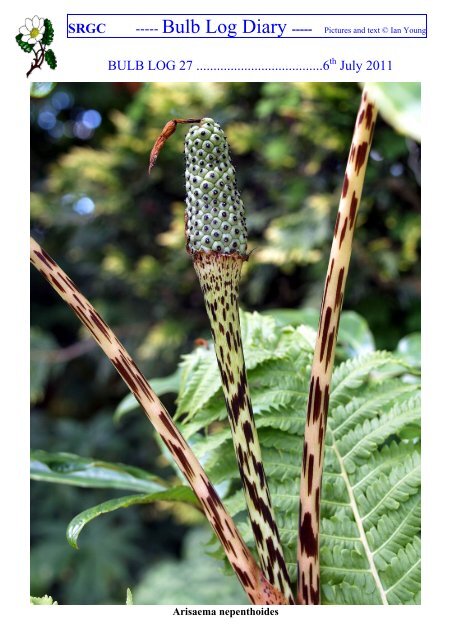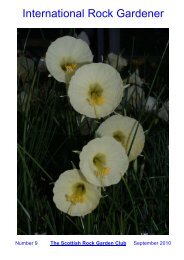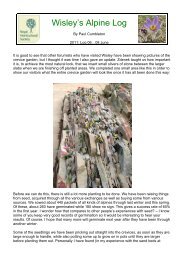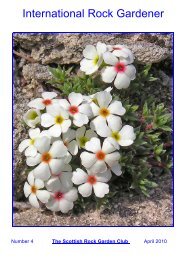Create successful ePaper yourself
Turn your PDF publications into a flip-book with our unique Google optimized e-Paper software.
<strong>SRGC</strong> ----- Bulb Log Diary ----- Pictures and text © Ian Young<br />
<strong>BULB</strong> <strong>LOG</strong> 27 .....................................6 th July 2011<br />
Arisaema nepenthoides
The opening shot this week is of the striking stems and seed head on Arisaema nepenthoides, one of my favourites<br />
of this attractive genus. As the season advances the berries will start to colour up and by the time they are ripe they<br />
will be bright red. They germinate well as the picture of a pot of seedlings sown in autumn of 2009 shows, you<br />
could not cram any more in. Around three weeks ago I noticed this pot had flopped due to lack of water so I placed<br />
it into a shallow tray of water. There has been water in the tray all this time and the plants are growing really<br />
strongly so maybe sitting with their bases in water is a good way to grow certain pots of seedlings. I will plant them<br />
out into the garden when they go dormant this year.<br />
Arisaema nepenthoides seedlings sown autumn 2009<br />
Arisaema flavum<br />
Always the last of the Arisaema to appear and flower in our<br />
garden is the tiny flowered Arisaema flavum – the flower is<br />
only 1-2 cms from the top of the stem to the top of the flower.
Crocus pelistericus<br />
Crocus pelistericus is the only species I grow that pushes its seeds up on such a<br />
tall stem and it does it remarkably quickly. The stem goes from nothing to<br />
almost the length of a pencil, pushing the seed capsule from underground to<br />
15cms above ground as it opens to reveal the precious contents. I suspect that<br />
Crocus scardicus does the same but I have never been lucky enough to get any<br />
seed set on our plants in over thirty years of growing it.<br />
Crocus pelistericus seeds
Erythronium seeds<br />
Plenty of other bulbs are setting seeds such as the Erythronium revolutum above.
Seat<br />
One of the seats in the garden where we can sit and contemplate and think which of the many tasks we should do<br />
first. My two main interests of gardening and art are similar in many ways one being that you never finish learning<br />
both in the theory and the practice and to that ends I am back to Art School all this week to do another master class<br />
on printmaking. As that is taking up most of my time this week I will leave the pictures to speak for themselves<br />
with just a few words<br />
Lilium martagon album
Lilium martagon album and Codonopsis cardiophylla<br />
Dactylorhiza<br />
On the left is Dactylorhiza ‘Eskimo Nell’ the beautiful white form that contrasts well with all the purple forms that<br />
we have. Both of these clumps are well spaced out because they were split up last year.
Dactylorhiza<br />
The Dactylorhiza really are the dominant flowering plant all around the garden just now.<br />
Fritillaria house<br />
You can see that there is not much happening in the Frit house as everything is dormant with just some seed to<br />
collect from the ripe pods.
Roscoea purpurea<br />
Roscoea purpurea seeds around as you can see from<br />
the mass of seedlings appearing from where the seed<br />
pods fell last year.
Roscoea alpina<br />
This is the true Roscoea alpine, not<br />
the pink form of Roscoea scilliflolia<br />
that so often masquerades under that<br />
name in many of the seed<br />
exchanges.
Roscoea scillifolia<br />
Roscoea scillifolia<br />
So o often seed of Roscoe scillifolia is what you<br />
get get when you ask for R. alpina alpina from from the the various<br />
seed exchanges. It is is the the fact that seed exchanges<br />
rely on the the donors donors to verify the the seed they are<br />
donating- so if you are growing these roscoea<br />
please take the the time to check they are true to<br />
type.
Roscoea cautleyoides<br />
This is a seedling and I am not sure if it is true roscoea cautleyoides or a hybrid with R. humeana.<br />
Roscoea humeana<br />
If I were asked to pick out a favourite species I would go for Roscoea humeana and if I were to narrow it down<br />
further it would be the stunning white form seen in the pictures below that close out this week’s bulb log.
Roscoea humeana alba<br />
Roscoea humeana alba<br />
The plants produce a progression of flowers over about four weeks with new ones replacing the fading ones.<br />
Hopefully each flower will be fertilised and produce some seed but they do not come true from seed. The largest<br />
majority of the seedlings will be the more typical purple colour with less than 5% turning out white. Sometimes<br />
none are white but it is well worth growing them on and collecting the seeds from the second generation because it<br />
may be that these seeds produce a higher ratio of whites,<br />
I love the delicacy of the purest white flowers and am fascinated by the way they turn translucent during periods of<br />
rain as seen in the last two pictures below.









